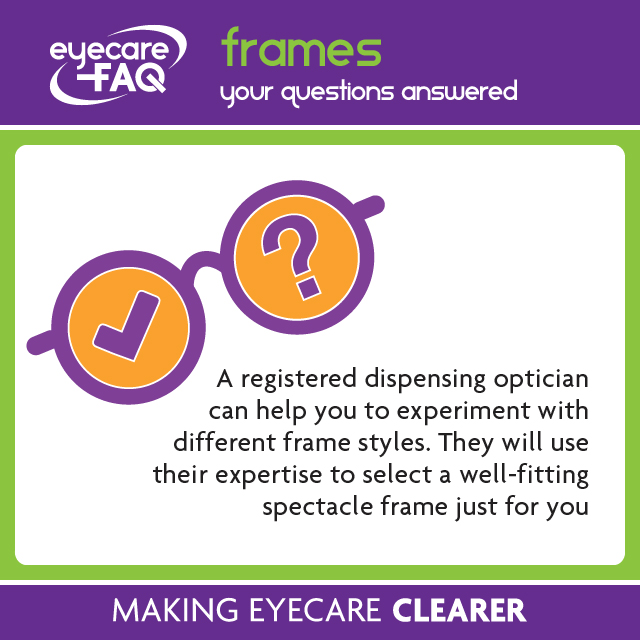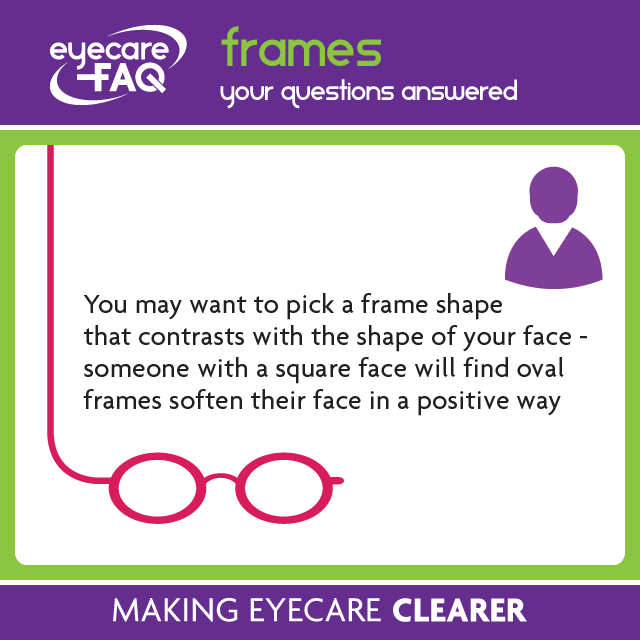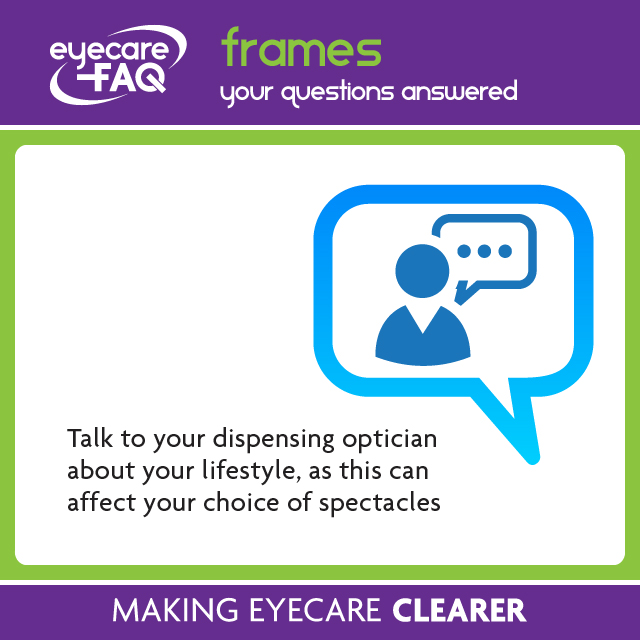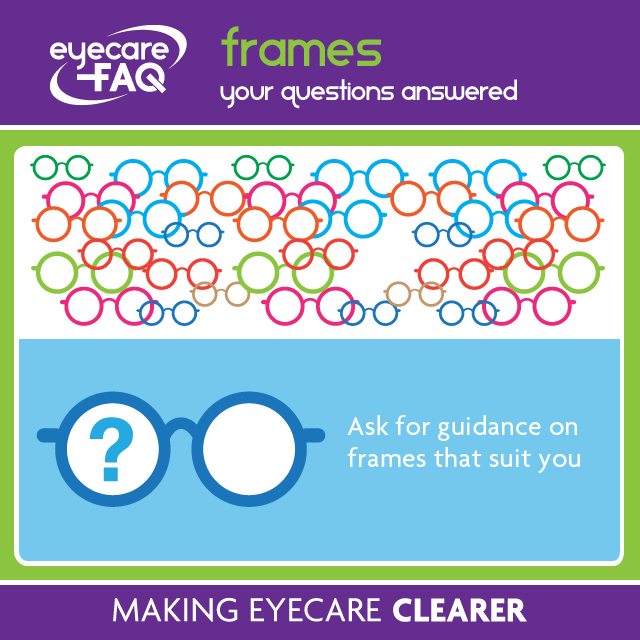It’s the first time I’ve needed spectacles. What do I need to know about choosing frames?
It can be bewildering looking at all the frames in an optical practice if you have never worn glasses before. A registered dispensing optician and the trained optical assistants in the practice can help you narrow down your choices and get the perfect pair for you.
Talk to your eyecare professional about your lifestyle and occupation, as this can affect your choice. You can choose between metal and plastic frames, and there are a wide range of lenses too. If you let them know your budget they can help you find frames and lenses best suited to you.
What are the pros and cons of metal frames?
Metal frames can be more flexible and easier to adjust than plastic frames. They tend to be slimmer and lighter. Titanium is the lightest material for metal frames, and there are also frames made of stainless steel or nickel alloys. In recent years flexible metal frames have been developed too. The colour choice is more limited in metal frames, but expanding all the time. Some people have metal allergies particularly to frames containing nickel alloy’s which can make a plastic frame a better choice: if you know which types of metal you are allergic to you can also opt for a frame of a different metal composition.
Always remember, you are not on your own when choosing specs. Ask for help from a registered dispensing optician.
What are the pros and cons of plastic frames?
Plastic frames tend to be a little thicker than metal frames, which can work well to conceal the edge of lenses, particularly if you are very short-sighted. Plastic frames can be made in a wide array of colours. Plastic frames can be safer for sport too: polycarbonate frames in particular are used in safety glasses because of their robustness. They are great for people who suffer with skin allergies were metal frames may be a problem.
Always remember, you are not on your own when choosing specs. Ask for help from a registered dispensing optician
What are the pros and cons of rimless frames?
Rimless frames are attractive to many people because they appear light and don’t hide the face. They are not as robust as specs with plastic or metal frames however, so won’t suit those with active lifestyles or small children who might grab and twist the frames. They can cost more, and won’t suit all prescriptions. Despite this, many people love the look of rimless glasses.
Always remember, you are not on your own when choosing spectacles. Ask for help from a registered dispensing optician to weigh up the pros and cons of different types of frames.
Which frames will suit my face?
It can be hard to pick a pair of spectacle frame to suit you. Here are three pointers to help you pick.
Firstly, make sure that the frame is the right size. The centre of your pupils should be approximately in the centre of the lens. Be careful about choosing oversized frames that stick out beyond the sides of your face as you can end up with unnecessarily heavy eyewear. If you have a smaller face, opt for smaller frames.
Secondly, think about your face shape. You may want to pick a frame shape that contrasts with the shape of your face. For example, if you have a round face you may want to pick a rectangular frame, while someone with a square face will find oval frames soften their face in a positive way.
Thirdly, pick frame colours to complement your skin and hair tones. If you have dark hair and eyebrows you can carry off a darker frame. Warm skins tones will suit gold tones, while cooler skin tones may look better with silver or gunmetal frames.
Always remember, you are not on your own when choosing specs. Ask for help from a registered dispensing optician.
What are the main face shapes and which glasses will suit which shape?
If you look in the mirror, it may be quite clear that you have a round, oval, rectangular or square face. Read on to find out how this can help you choose spec frames to suit you.
A round face often suits rectangular spec frames. They can help lengthen the face.
A square face with a strong forehead and jaw can be softened with narrow, oval frames.
A rectangular face can seem long and thin. Balance this out with deeper oval frames.
People with oval faces are lucky and can suit many shapes of frames.
If you have a larger or longer face you can benefit from decorative features, bold colours and thicker rims on your specs, while a small face will benefit from a simpler, slim, light frame that doesn’t overwhelm the face. Choosing a frame that is as wide as the widest part of the face is good advice for all.
Always remember, you are not on your own when choosing specs. Ask for help from a registered dispensing optician.
What makes a frame a good fit for my face?
Each pupil should be in the centre of the lens. The frame should be level with your eyes and eyebrows: ask the dispensing optician if a frame can be adjusting to be level and comfortable. The width of the frame should match the width of your face. The side of your specs should run along the side of your head without cutting in. Once they reach the ear the sides should curve downwards. If the sides curve too early, they can push the frame down on your nose and rub behind your ears. With a plastic frame there should be no gap between the bridge of the frame and the bridge of the nose. Metal frames generally have nose pads which will be adjusted so that they sit parallel to the sides of your nose. The lower edge of the frames shouldn’t touch your cheeks, so that they don’t rub or irritate.
Not everyone’s face is perfectly symmetrical, so don’t worry if your specs don’t appear symmetrical when you lay them on the table: the important thing is that they should be level on your face.
How do I pick the right frame width for my face?
The width of the frame should match the width of your face. This means, when looking at you straight on, the glasses should not be significantly wider that your face, nor should the sides cut into your cheeks or temples. The sides should not be “pushed out” when sitting on the head: if so the frame is too small.
How often should I go back to have my specs adjusted?
There is no set rule for this: return to the opticians for readjustment as often as you need. The fit of your specs will alter with wear as you flex the frames every time you take them off and on. Remove your specs carefully with both hands to ensure that you don’t stretch one side. Some people need very few adjustments, but with growing children you may find periods where they need to visit every week to stop the specs slipping. The Dispensing Optician is trained to ensure that your specs fit well, and will be happy to help however often you need to return.
What size spectacle frames are right for me?
Spectacle frames often have their size printed into the side or bridge of the frame. There are three numbers, such as 50-20-140. The first figure is the eye size, the second is the distance between lenses, and the third is the side length. While this seems simple, different styles of frame may have the same measurements but fit differently.
Always speak to a Registered Dispensing Optician about the right frame size for you.
I want a big fashionable frame: why have I been advised against it by my optician?
Not all spectacle prescriptions work well in all frames. If you have a high prescription, you should avoid spectacle frames that are much wider than your face. Deeper and wider frames will be heavier, because the lens will need to be larger. This can also lead to chunkier lenses – thicker at the edge if you are shortsighted and in the centre if you are longsighted.
I wear varifocals: what frames will work best?
Varifocal lenses have different areas within each lens for distance, intermediate and near vision. Choose a frame with sufficient depth to allow you to make the most of all three areas. Ask your Registered Dispensing Optician for advice before picking a frame.
How do I choose light and comfortable glasses?
If you want the lightest spectacles, choose a small frame and ask for high index lenses. Plastic lenses are lighter than glass lenses. The optician can discuss other enhancements to the lenses, so that they are made as thin as possible for your prescription. To ensure that your frame is comfortable, seek advice from the Registered Dispensing Optician before choosing. They will advise you on frames that will work well for your face. They will adjust the frame to fit you too, so you can be sure that you have the most comfortable specs that you can.
How do I choose a well-fitting frame from an online store?
It is very hard to choose a well-fitting spectacle frame online. Every person’s face is different, so what looks good on a model may not suit you. Different styles of frame may have the same measurements but fit differently. Always speak to a Registered Dispensing Optician about the right frame for you.
My glasses leave red marks on my nose, what should I do?
There are a number of causes of red marks on the nose. The first thing to do is to return to the optical practice where you bought the spectacles and speak to the registered dispensing optician. They will be able to look at the fit of the frames and adjust the position of the nose–pads. Larger nose–pads can help spread the weight of your glasses. If the weight of your spectacles is a continuing problem, you may want to consider smaller frames and/or thinner and lighter high index lenses when you next purchase glasses or ask your registered dispensing optician about contact lenses. In a very few cases red marks where spectacles touch the skin may mean an allergy to the frame or nose–pad material: ask your dispensing optician for advice.
My glasses rub behind my ears, what should I do?
The side of your specs will be adjusted when you collect them to fit well behind the ears. Occasionally you may need to return if you experience discomfort behind the ears. The Registered Dispensing Optician will gently warm the sides of your frame and adjust the bend so that it doesn’t rub. You can return for regular adjustments to ensure that your frame remains comfortable.





